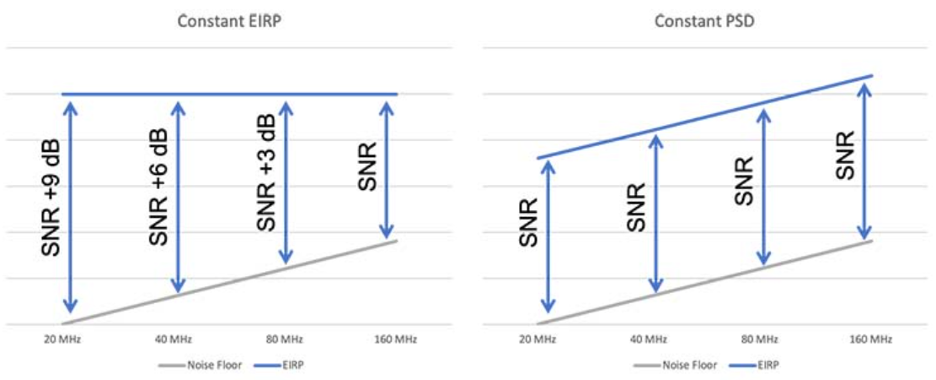Most Wi-Fi folks are familiar with and understand the concept of EIRP to represent power, although they may not know what exactly it stands for, which is Equivalent Isotropically Radiated Power (EIRP). Some vendors use EIRP to represent the transmit power of an access point, others use total power out and others still use per chain transmit power. Whatever the notation, they’re all cut from the same cloth, meaning they measure essentially the same thing, just at different parts in the RF path. Regulators typically set EIRP limits for Wi-Fi devices to comply with: among several other requirements, one of which is Power Spectral Density (PSD – the topic of this blog. Upon reading this blog, the reader should have a better understanding of PSD and how it relates to EIRP.
In the Wi-Fi industry, we’re used to a constant EIRP across channel bandwidths and haven’t really had to care about PSD. Wi-Fi 6E will change that model. With 6E, we’re moving to a constant PSD, which means effective EIRP increases and decreases by 3 dB per channel width. When the channel bandwidth is doubled, so is the effective power, but PSD remains constant.
What is Power Spectral Density?
Power Spectral Density is the amount of power over a given bandwidth. In the US, Wi-Fi 6E low power indoor devices must comply with a spectral density of 5 dBm/MHz (there is a proposal to increase PSD to 8 dBm/MHz, which is still open as of this writing).
One of the tradeoffs in Wi-Fi and RF in general is that each time the channel bandwidth is doubled, the noise floor is also doubled (increased by 3 dB). In existing frequency bands, with constant EIRP, we achieve the maximum SNR with 20 MHz channels. 80 MHz channels actually take a 6 dB SNR hit compared to 20 MHz, making it a challenge to use the wider channels for high density deployments (and also limited bandwidth availability).
Instead, if we keep PSD constant, as we can do with Wi-Fi 6E, every time the channel bandwidth is doubled, we still take the noise floor hit, but we can also double EIRP. In effect, we’re able to keep a constant SNR and effective EIRP across channel widths, since wider channels are able to enjoy higher EIRP than lower channel bandwidths.
These graphs (below) illustrate the relative SNR for existing constant EIRP we are used to and the new constant PSD in 6E across channel widths. The constant PSD in 6E ensures the same SNR across channel widths, allowing the use of wider channels without a signal quality penalty.

Converting between EIRP and PSD
We can convert between PSD and EIRP with this formula:
EIRP = PSD + 10log(channel width)
21 dBm EIRP = 5 dBm/MHz PSD + 10log(40 MHz)
Reference of PSD and EIRP for Low Power Operation

Note: Standard power APs follow the same constant EIRP rules as existing UNII-1 and 3, which has a limit of 36 dBm. Client devices in Wi-Fi 6E, for both low power and standard power operations, are restricted to 6 dB lower than the access point.
The use of wider channel widths – 40MHz, 80 MHz, or in some cases, even 160 MHz – is expected to be more common with Wi-Fi 6E, due to the massive amount of available spectrum and that there will no longer be SNR tradeoffs by using wider channels. To put things into perspective, we have more 40 MHz channels in 6 GHz than we do non-overlapping 20 MHz channels in 2.4 and 5 GHz combined. We have more 80 MHz channels in 6 GHz than we do 40 MHz in 5 GHz. And seven 160 MHz channels will be viable in some deployments as well. We expect 40 and 80 MHz channels to be widely deployed in 6E, and 160 MHz to see use as well in certain enterprise deployments.


